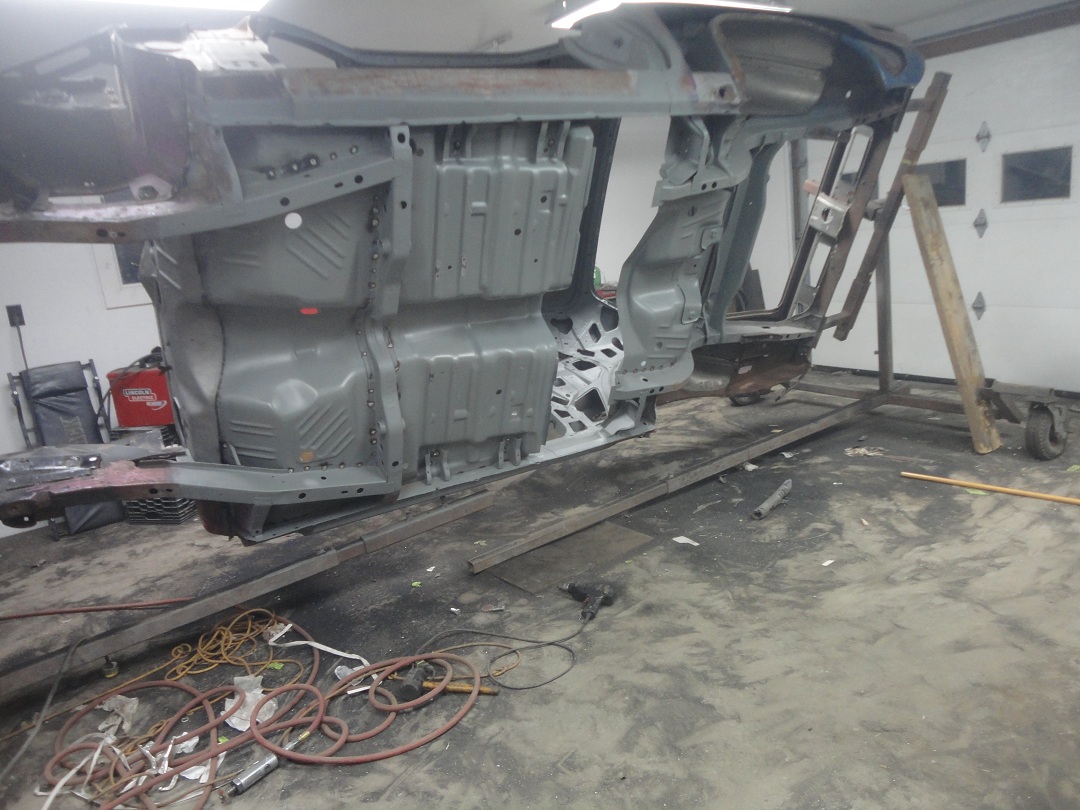 38) Here is the underside. The reason why I primed the underside of the floorpans before installation is that there
are a lot of areas that can't be primed very well after the pans are installed. Priming them before installation
allows me to protect those areas a little better than just leaving them with the black primer on them.
38) Here is the underside. The reason why I primed the underside of the floorpans before installation is that there
are a lot of areas that can't be primed very well after the pans are installed. Priming them before installation
allows me to protect those areas a little better than just leaving them with the black primer on them.
|
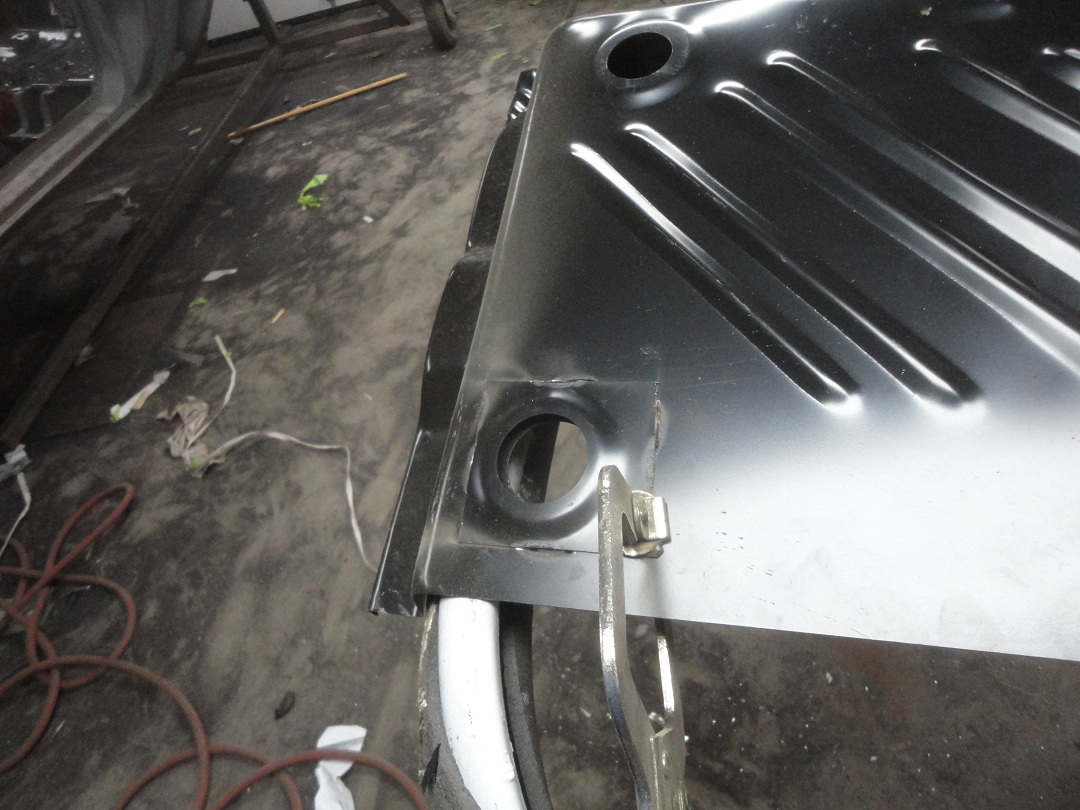 39) The rear toe pans also needed some work. The rear most floor pan plug holes were undersized for the plugs, which is
just a matter of drilling the holes out. The bigger problem is that the front plug holes were dippled in the wrong
direction. They were dippled up instead of down. To fix it, I had to cut sections out of each floor pan and weld them
back in upside down (from the way they were stamped).
39) The rear toe pans also needed some work. The rear most floor pan plug holes were undersized for the plugs, which is
just a matter of drilling the holes out. The bigger problem is that the front plug holes were dippled in the wrong
direction. They were dippled up instead of down. To fix it, I had to cut sections out of each floor pan and weld them
back in upside down (from the way they were stamped).
I cut one from the right pan and clamped it in the correct orientation on the left one (shown here). I used the new piece
as a template for cutting out the left side. That way I had at least one piece that was a perfect fit for the hole.
|
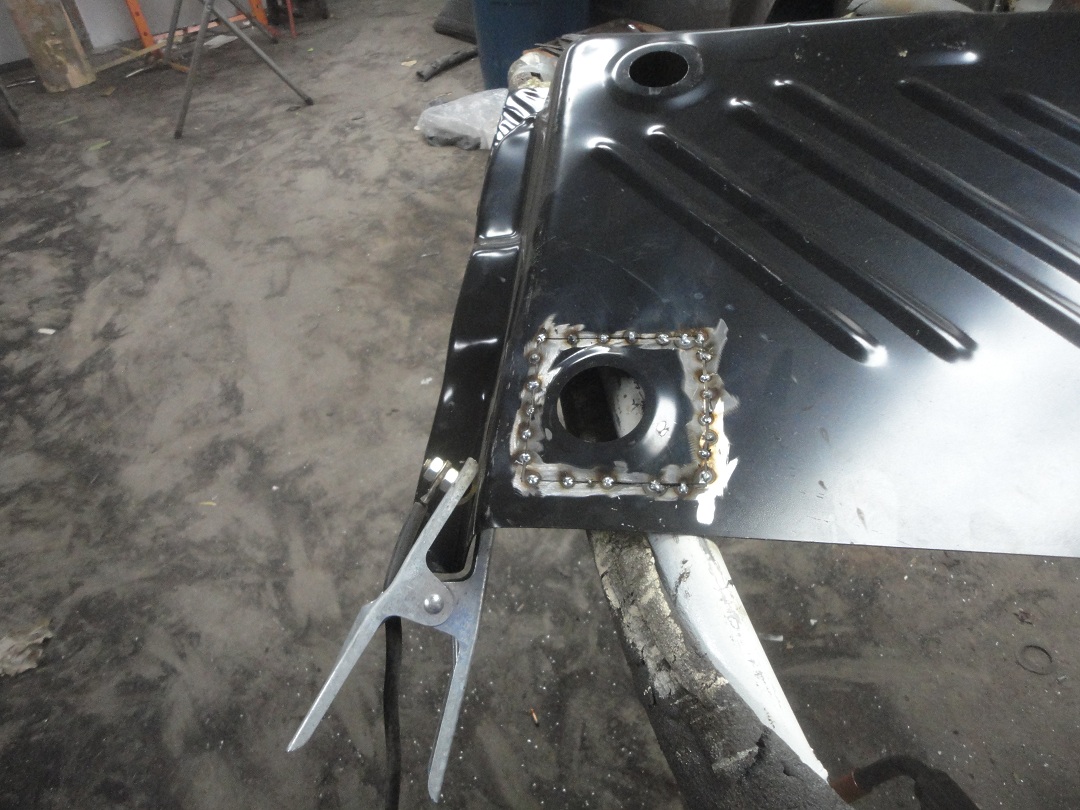 40) I explain the butt-welding process in much greater detail on my other car project pages, so I will only touch on it
lightly here. The new piece is held in place over the old piece. The old piece (underneath) is cut out using the new
piece as a guide. The new piece is welded in place using tack-welds around the perimeter. Air is blown onto each weld to
cool the metal as each weld is being applied. Tack-welds are continued to be applied around the perimeter inbetween
each previous tack-weld. This is done until no voids are left.
40) I explain the butt-welding process in much greater detail on my other car project pages, so I will only touch on it
lightly here. The new piece is held in place over the old piece. The old piece (underneath) is cut out using the new
piece as a guide. The new piece is welded in place using tack-welds around the perimeter. Air is blown onto each weld to
cool the metal as each weld is being applied. Tack-welds are continued to be applied around the perimeter inbetween
each previous tack-weld. This is done until no voids are left.
|
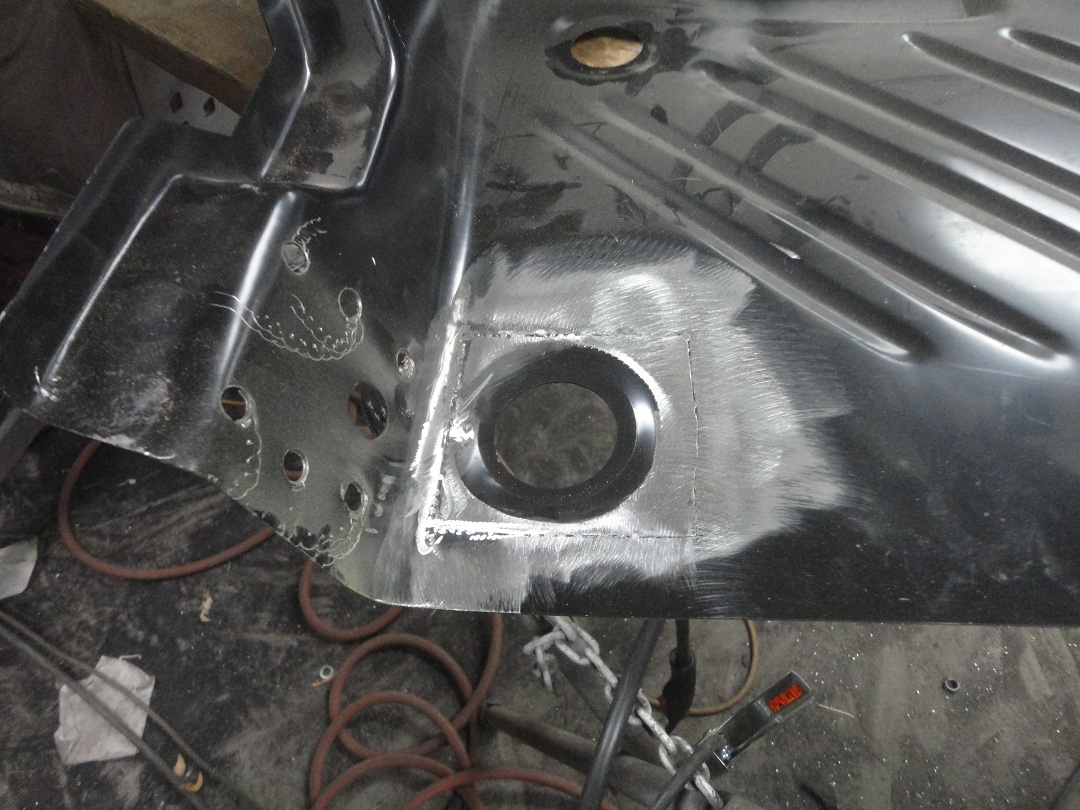 41) Butt-welds don't generally penetrate all the way through unless you champer the cut edges. This picture shows what I am
talking about. In this case I applied tack-welds from the oposite side of the weld (the side shown). Then the welds are
ground down. Usually with a grinding disk.
41) Butt-welds don't generally penetrate all the way through unless you champer the cut edges. This picture shows what I am
talking about. In this case I applied tack-welds from the oposite side of the weld (the side shown). Then the welds are
ground down. Usually with a grinding disk.
|
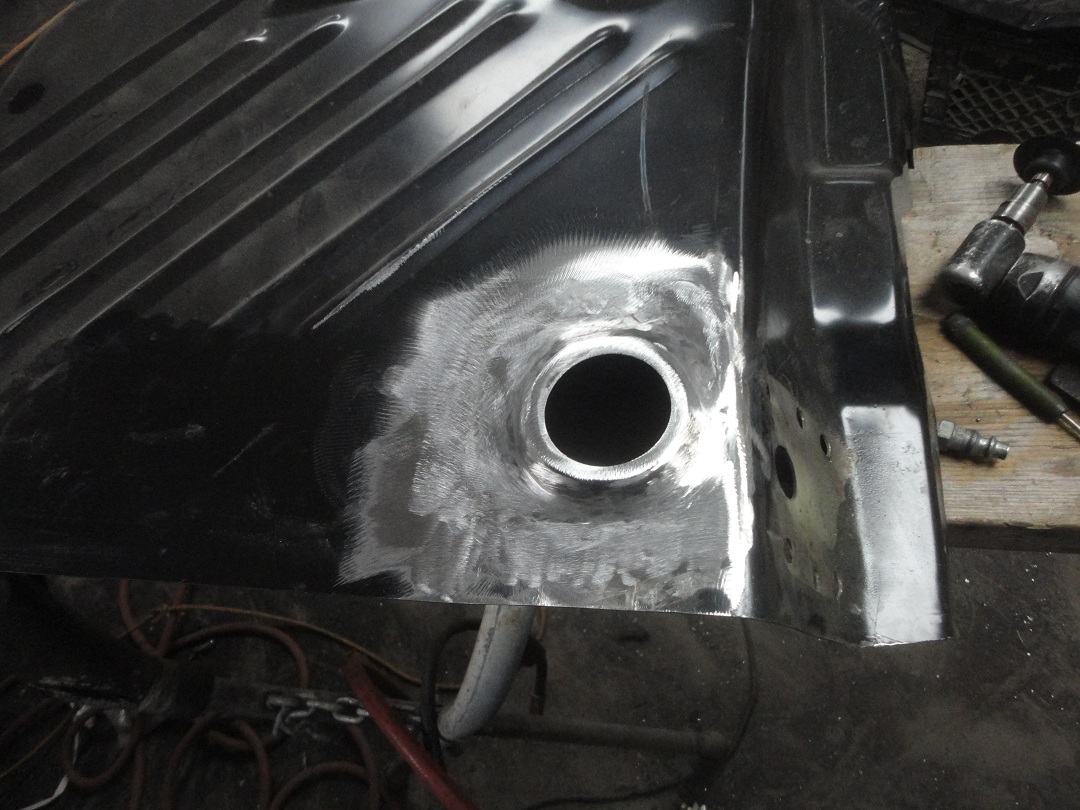 42) Here is a view of the underside all ready for epoxy primer. This came out so good that no filler will be required.
42) Here is a view of the underside all ready for epoxy primer. This came out so good that no filler will be required.
|
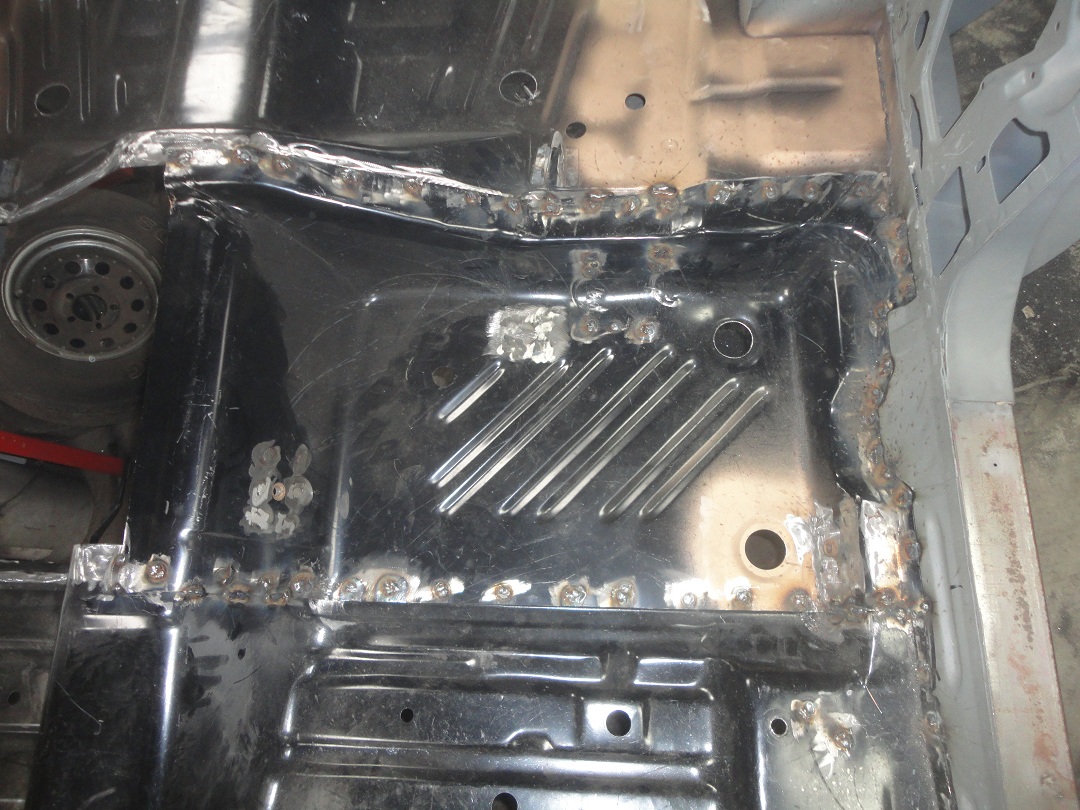 43) Here the left rear toe pan is welded in. The rear plug hole has been drilled to the correct size, the original seat belt
anchor plates are welded in and the e-brake cable bracket is welded in (not shown, on underside of pan)
43) Here the left rear toe pan is welded in. The rear plug hole has been drilled to the correct size, the original seat belt
anchor plates are welded in and the e-brake cable bracket is welded in (not shown, on underside of pan)
The one additional thing I would like to say is that the toe pans do not fit the curve of the front portion of the frame
rails. This doesn't seem to be a flaw in the repo part. It appears the original factory parts were just as bad. I have
observed this on many cars.
|
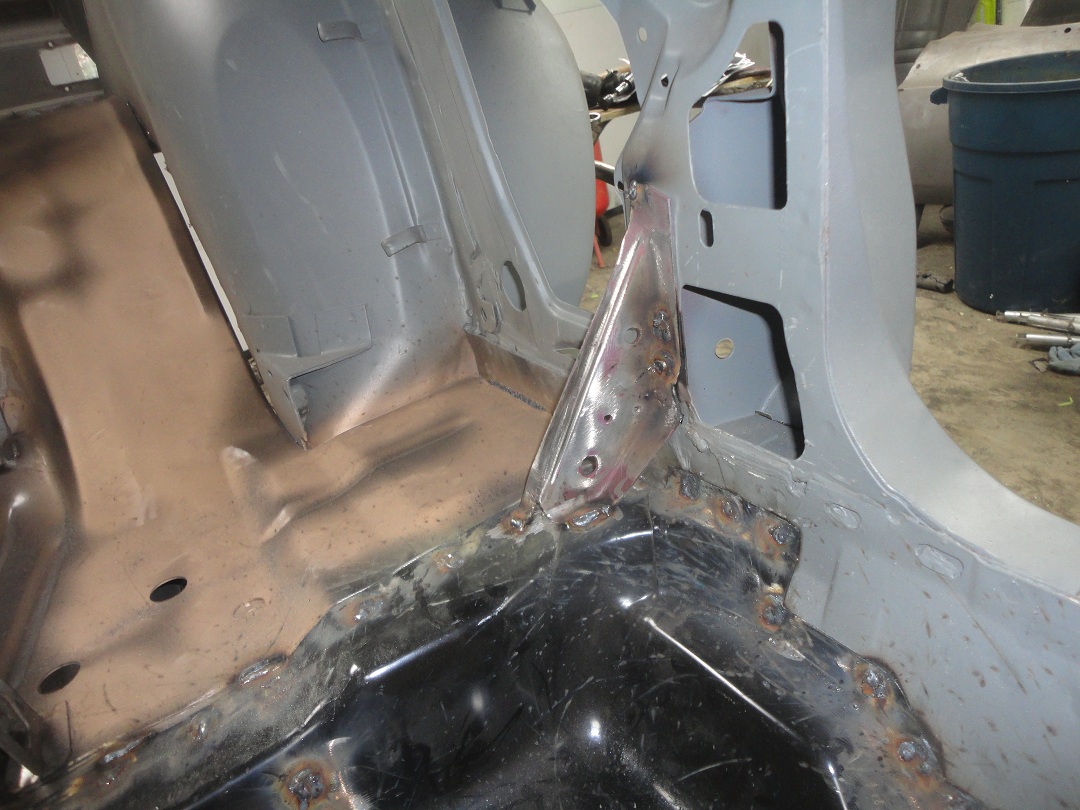 44) The B-pillar brace goes on after the toe pans.
44) The B-pillar brace goes on after the toe pans.
|
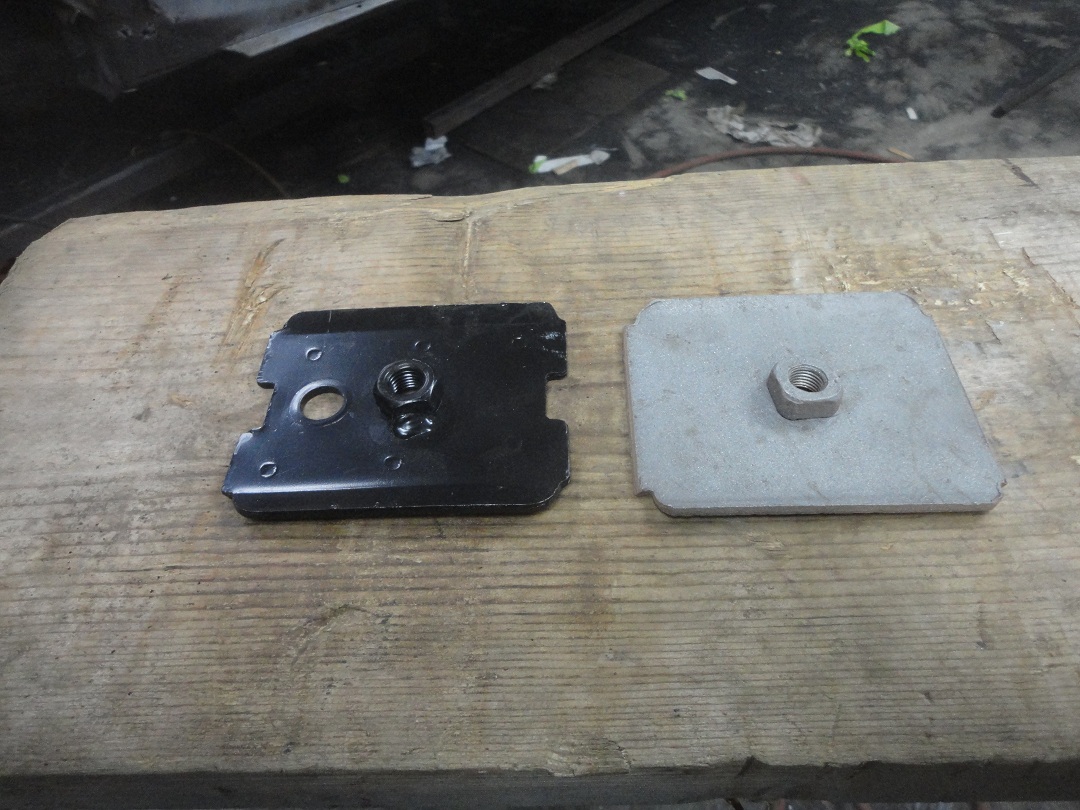 45) Here is why I used the original seatbelt anchor plates. There are lots of diffrences, but the most import thing to know
is that the repo has the wrong size nut (at least for a 1970).
45) Here is why I used the original seatbelt anchor plates. There are lots of diffrences, but the most import thing to know
is that the repo has the wrong size nut (at least for a 1970).
|
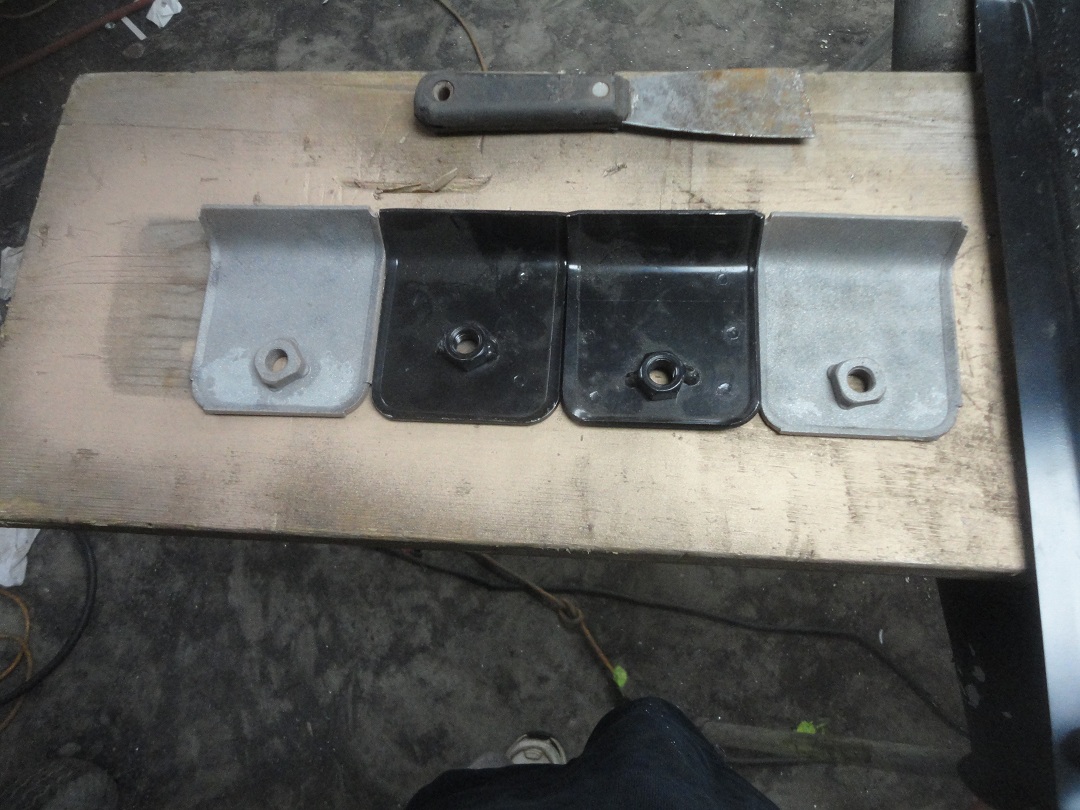 46) Here are the outboard ones that are visible when looking underneath the car. One of the repos had the nut mounted in the
wrong location (not to mention that it is also the wrong size and style). I had to a drill a new hole in the LH toe pan
to use the original plate.
46) Here are the outboard ones that are visible when looking underneath the car. One of the repos had the nut mounted in the
wrong location (not to mention that it is also the wrong size and style). I had to a drill a new hole in the LH toe pan
to use the original plate.
|
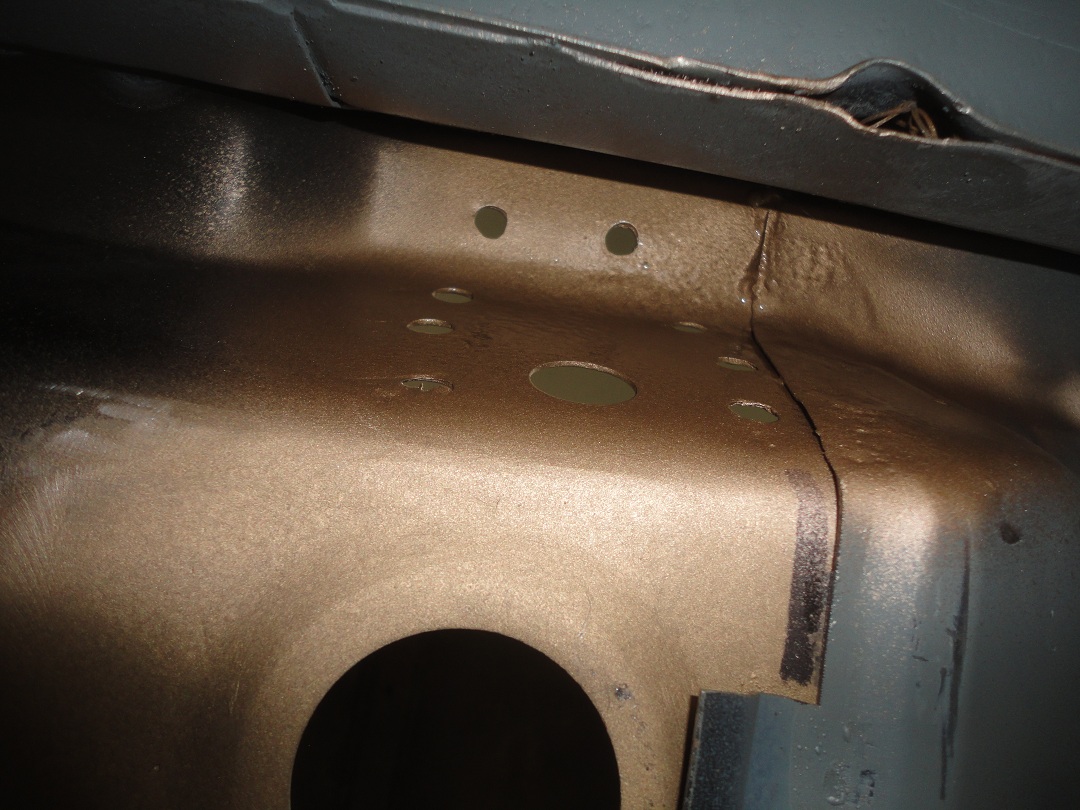 47) The repo pans come with the seatbelt anchor plates welded to them. For the left side I was able to change out the
brackets and weld the pan in. For the right side I had to weld the seatbelt anchor plate in after I
welded the toe pan in because the seatbelt plate overlapped the front floor pan. Strangely enough, the original floor
pans had the same problem from the factory.
47) The repo pans come with the seatbelt anchor plates welded to them. For the left side I was able to change out the
brackets and weld the pan in. For the right side I had to weld the seatbelt anchor plate in after I
welded the toe pan in because the seatbelt plate overlapped the front floor pan. Strangely enough, the original floor
pans had the same problem from the factory.
In this picture you can see where the right side seatbelt anchor plate was going to be welded.
|
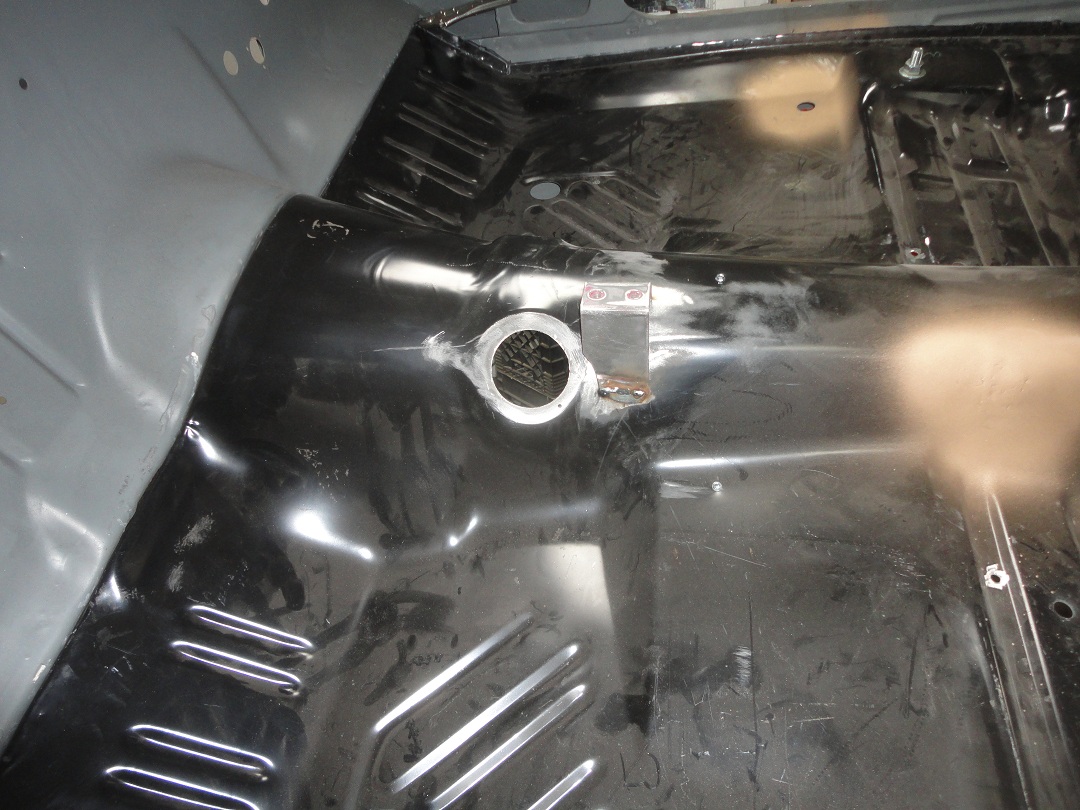 48) The last bit of welding on the floors was to install the console and shifter brackets. The hole for the
automatic shifter wasn't drilled so I had to go out and buy a hole saw just to drill the one hole.
48) The last bit of welding on the floors was to install the console and shifter brackets. The hole for the
automatic shifter wasn't drilled so I had to go out and buy a hole saw just to drill the one hole.
The shifter boot and linkage was used as a reference to position the bracket to the floor before welding.
|
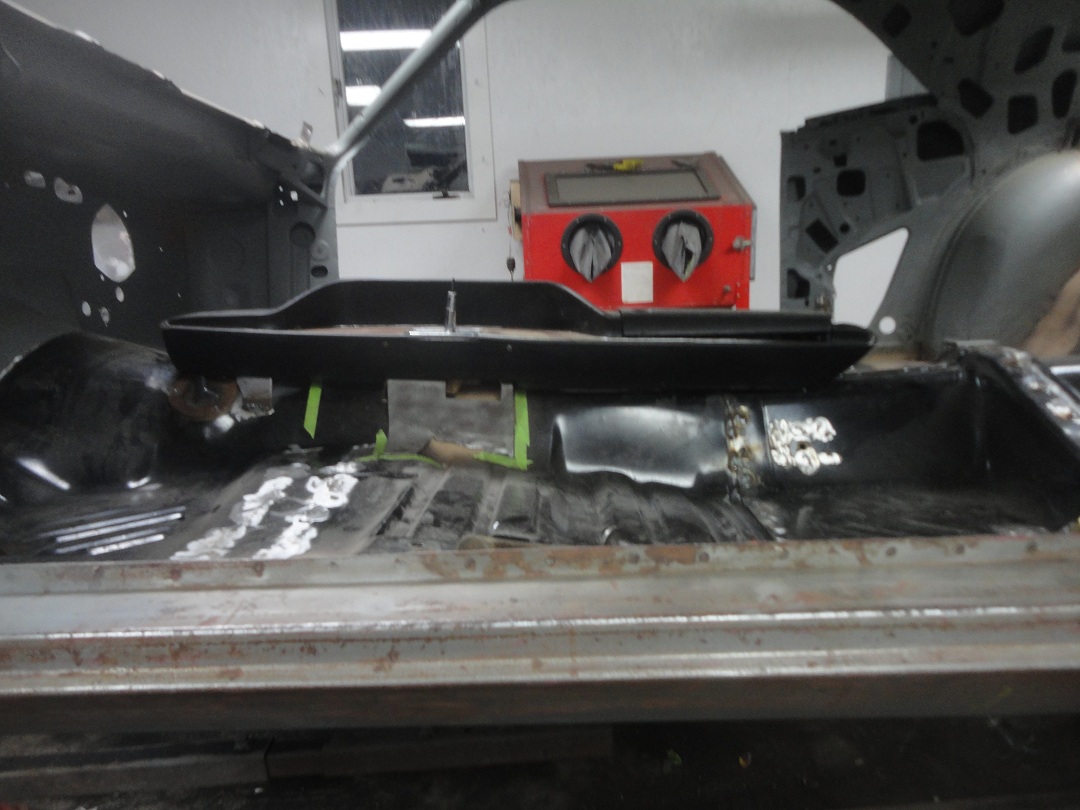 49) The console took a bit of time since the hump on the repo floor was not quite the same as the original one. I used
the console and shifter to help position the brackets. The trick was to set the brackets so that the woodgrain
panel was not raised up by the shifter. This was probably fixed by 1971 when Dodge added a 5th screw to the panel.
49) The console took a bit of time since the hump on the repo floor was not quite the same as the original one. I used
the console and shifter to help position the brackets. The trick was to set the brackets so that the woodgrain
panel was not raised up by the shifter. This was probably fixed by 1971 when Dodge added a 5th screw to the panel.
|
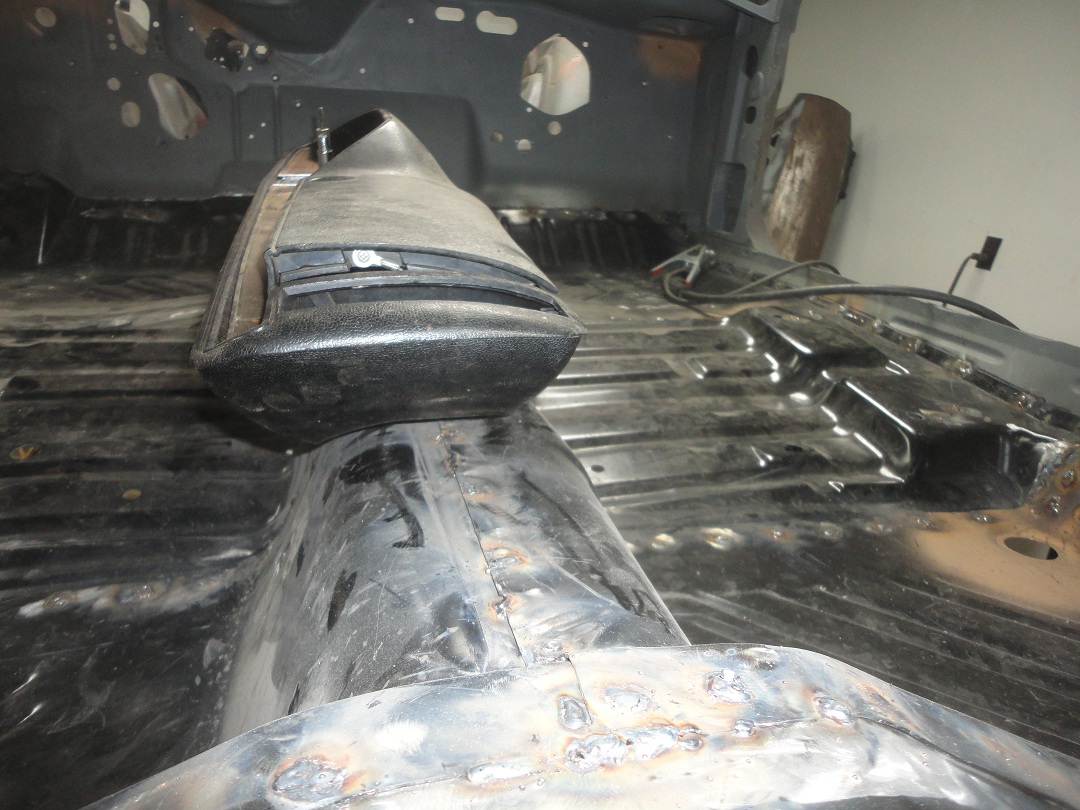 50) This rear view shows how the rear of the console overhangs the center hump on the driver's side.
50) This rear view shows how the rear of the console overhangs the center hump on the driver's side.
|
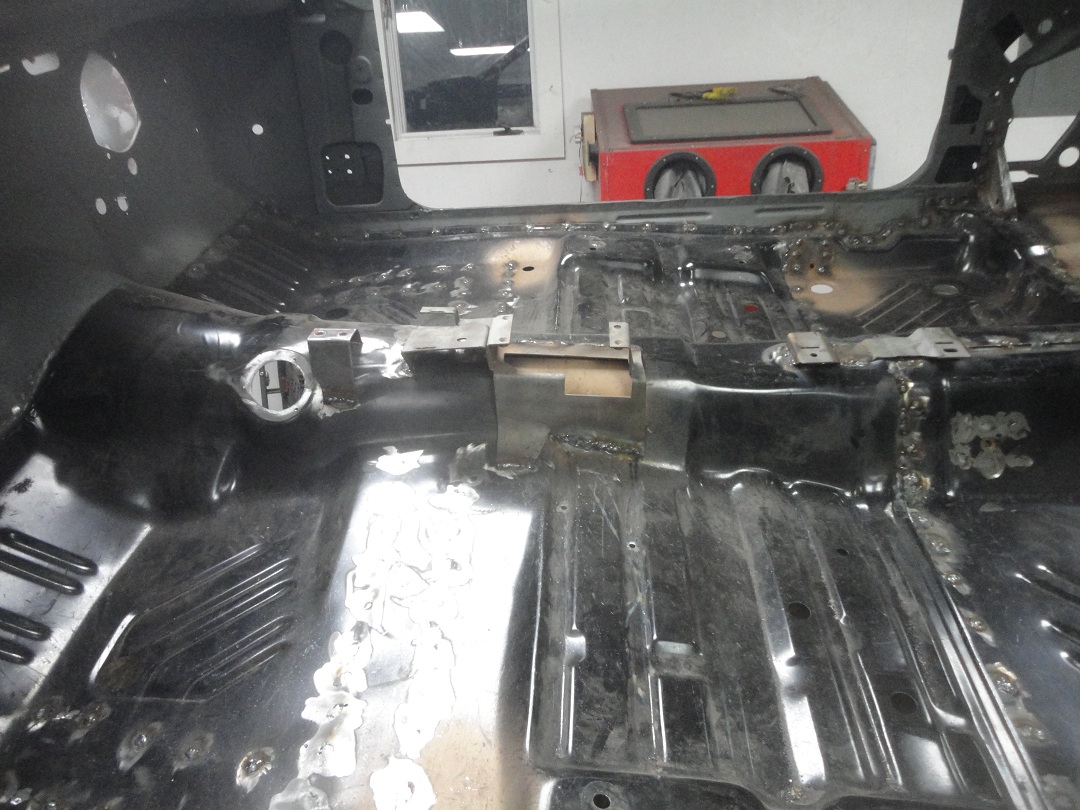 51) The brackets were tack welded in place and the console was refitted (with the shifter) to ensure everthing was in
the correct position before the brackets were fully welded to the floor.
51) The brackets were tack welded in place and the console was refitted (with the shifter) to ensure everthing was in
the correct position before the brackets were fully welded to the floor.
|